by tmoffett | Jul 23, 2012 | Color, Composition, Critique, Landscape, Photographic Technique, Uncategorized
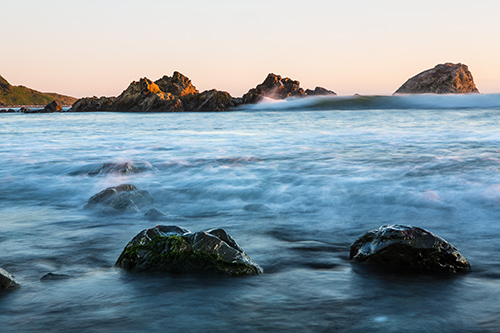
Ocean View, Crescent City, CA
I haven’t been out photographing for a few days and I am starting to get a bit antsy. I have been sitting in front of my computer getting some much needed work done, but I need to photograph. It doesn’t matter that I have a backlog of images to process and other tasks that need worked on, the need to make new images is always there. I guess that means I am a photographer. It is in my blood.
I pulled this image to post from my last trip to the coast. We were in Crescent City, California to photograph the Redwoods, but when I am close to the ocean, I will always find time to spend there. The evening I made this photograph, the sky was naked and colorless, so I really focused on the sea. One thing that I stress in my classes and workshops is to work the camera angles. Many times, especially at the ocean, I find photographers up on the beach, away from the water but shooting the water from a high angle. Not me. I like to be in the water. I try to find a lower angle to shoot from, as this will emphasize the foreground objects better. I have found that if I press my tripod down in the sand it becomes very stable. Unless a big wave slams into the tripod, it is remains quite stable in the water even at long shutter speeds. This image is a 1.3 second exposure, tripod legs buried under about 18 inches of water and waves hitting the tripod legs. The image is still tack sharp. When photographing this way you must keep an eye on the incoming waves, as occasionally a sleeper wave will come out of nowhere and you better be ready to move or risk soaking all of your gear. For this image, I actually wanted to get lower, but when I did, the incoming waves blocked the view of the rocky background too much.
One thing I really like about this image is not only the emphasis on the foreground rocks, but how the low angle also enlarges the size of the wave coming in. The wave creates a nice transition from ocean to rock in the background. I know it is hard to see in the small image here, but the water is packed with texture, detail and subtle color shifts, showing the warm light of the setting sun reflecting off of the highlights, but the deeper parts of the water remain a rich and vibrant blue. There is a lot of life in the finished print.
by tmoffett | Jul 17, 2012 | Color, Landscape, Photographic Philosophy
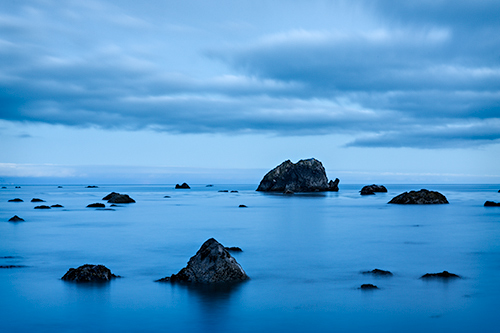
Still
The ocean, during the day is alive with activity. It is an exciting place to be. I love beachcombing with my kids collecting all kinds of interesting rocks and shells. Letting the waves crash into you and nearly knocking you down is a fun experience. Watching surfers catch the waves and riding them ashore, flying kites, tidepooling, and the list of activities goes on and on. When the sun sets, though, something magical happens. Everything seems to slow down, at least in my minds eye it does. The sounds become soothing, the fresh ocean breeze is calming to the soul. Yes, the waves of the rising tide are still crashing into the rock lined shore, but in my minds eye I see something entirely different. A long exposure smooths the surface of the wild sea and calms the waves crashing ashore. The cool blue sky bathes the scene in rich cool tones that create a very soothing effect on the viewer. This is what I come to the ocean for!
Previsualization, being able to recognize what it is I really see, and then being able to successfully render that image with the camera is what creative photography is about. Anyone can shoot a thousand images and then find a good one, but to be able to consistently render your feelings in an image is something entirely different. You must know your tools and understand how to use them if you are to create photographs that exhibit what your minds eye sees. It is not so much about what you physically see, but how you interpret what you see.
by tmoffett | Jul 9, 2012 | Color, Landscape, Photographic Philosophy
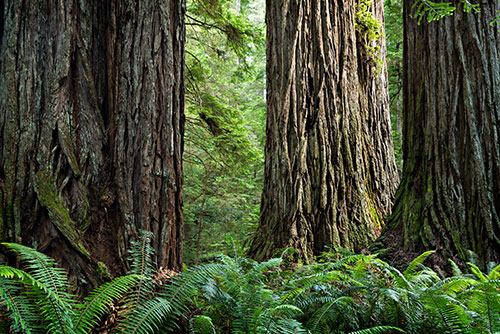
Grove of the Titans
A couple of weeks ago I was on a family trip to see the Redwoods, and as usual, I mixed in a little photography as I do with every trip. The first morning I was up before 5:00 AM to make sure I would capture the morning sweet light and headed up Howland Hill Road into the Jedediah Smith Redwoods State Park toward Stout Grove. One nice thing about being a photographer and getting up early is that you have the world to yourself. When I arrived at the grove, not another soul was around. It was just me and the trees. Peaceful and quiet, I was left to think, meditate and photograph. The experience was awesome, but that is not what I want to talk about today.
After some time of photographing, I heard footsteps behind me, and I turned around and met a wonderful man from New Jersey. He had done a lot of research on the redwoods, and clued me in to a couple of groves of trees that are a bit off the beaten path, and are quite hard to locate without help. Park rangers will not disclose their locations, as they hold some of the largest trees in the world. One of those groves is the Grove of the Titans, home to the 1st, 4th and 5th largest Coastal Redwoods in the world. These massive trees have bases up to nearly thirty feet in diameter. Ten feet is huge, but thirty? To me it was unimaginable. I decided to take my wife and kids with me later that day to locate the grove and then return in better light to photograph.
In the afternoon the five of us headed out on what turned out to be quite the adventure. The first mile or so was a breeze as we were on a well marked and maintained trail. Then the adventure. I knew that we needed to veer off the trail, and we quickly found ourselves bush whacking through dense ferns that were taller than me, although at my height, that is not too difficult! We climbed over downed trees covered in moss and unstable root systems where, if not extremely careful, we would find ourselves slipping and risking twisted ankles or worse. After some time, my youngest two children (13 and 8 years old) had had enough and felt we should turn back. My older son and I felt like we were on the verge of something exciting and move on while my wife turned back with the others. As they turned back, we surveyed the situation and determined that we needed to drop down into the small valley and cross the stream, which we did. As we climbed the bank on the other side…WOW! I have never seen such large trees.
As my son and I stood in the middle of this circular grove of giants, I was speechless. We both stood in silence for a minute, and then my son spoke, “Something happened here.” I was overwhelmed. It was as if we were on sacred ground. I have been in some pretty special places, and the feeling here rivaled the feeling I have had in those other places. I felt like I was in an ancient temple of sorts. I knew that I must come back and photograph, while at the same time I knew that I could in no way do justice to the scene in front of me.
The next morning I arose early again, and with my wife headed to the grove. We arrived, much more quickly this time, as we knew the location and found an easier way in. I sat in the center of the grove again and took it all in. This grove is a large open circle formed by 9 of the largest trees I have ever encountered. In the center is a small mound on which I stood. Again I was in awe of what nature presented me with. I set my camera on the tripod and began photographing, trying desperately to photograph what I felt. The massive tree trunks, tall and majestic, overpower anything and everything in their presence. The quiet, the peace, the beauty of it all leaves in my mind an assurance that there is a God, a Creator who is in control and wants me to enjoy His creations.
Again, as I left the grove, I felt like I was leaving sacred ground. There was a feeling difficult to portray in images. It was something that had to be experienced.
by tmoffett | Jun 20, 2012 | Color, Landscape, Photographic Philosophy
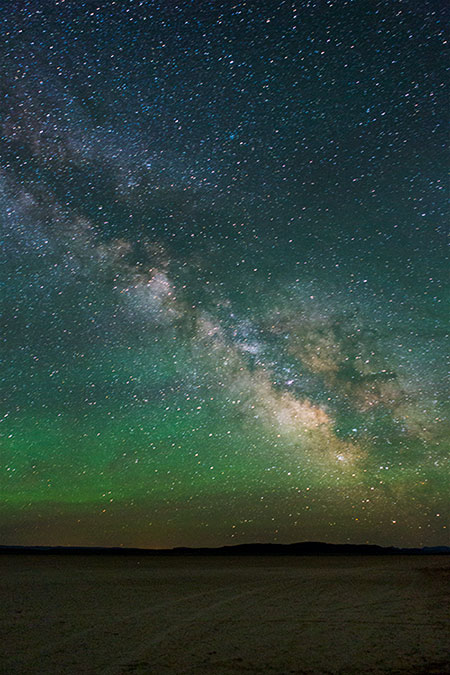
Milky Way
I had never been to the Alvord Desert in Southeastern Oregon, but had heard that it was an interesting place, so yesterday my youngest son and I went to explore. We had no idea what we were in for. All we had was a road map, cameras and sleeping bags. It was just what I needed. A spur of the moment trip to an unknown location that would offer photographic opportunities outside of my “normal” shooting style (comfort zone). When feeling in a rut, this type of activity is one way, at least for me, to get me jump started again. I may not come back with a great piece of art, but it is great for my state of mind.
After a longer than expected drive we finally arrived just a few minutes before the sun dropped below the Steen Mountains, so there was not a lot of time to explore. It has been a while since the area has had rain, so there were many vehicle tracks winding their way around on the playa. Most of my photography has very little reference to man, so this was a bit troublesome for me. I really had to think of ways to use the tracks to my advantage. I was not very successful at that, so I moved to the edge of the playa and focused on the foliage growing up through the playa.
Before long the light was gone, and it was time for us to eat smores and then get ready to photograph the stars. In my 30 plus years in photography, I had never photographed the stars. I have always been the one to get to bed so that I could get up early for sunrise, but on the night of a new moon out in the middle of nowhere, I thought it would be a good time to try something new. Now, I am not sure what took me so long to try this! I can see how this could be addictive.
There are great images just waiting to be made at all hours of the day or night. Even though I may not have come back with that incredible photograph that I am always searching for, I did come home with some new ideas that, at a future time, will become great images.
by tmoffett | Jun 14, 2012 | Color, Composition, Landscape
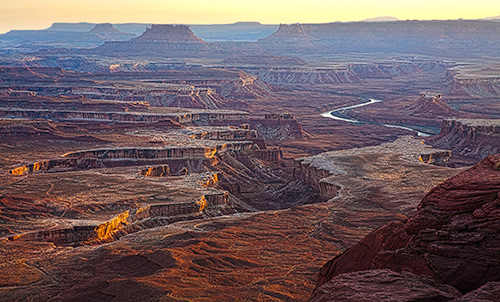
Canyonlands, Green River Overlook
I have been revisiting some images from past photo safari’s that I have taken and found this image from Canyonlands in Southern Utah. This is an area that I would very much like to visit again. The red rock canyons are very unique, and under good lighting conditions seem to glow. It is something that I don’t have here in Idaho (although we do have other features unique to us). I love, in this image, how the setting sun reflects off of the canyon walls, creating a warm glow that opens up the deep shadows deeper in the canyon. It also is full of dynamic lines zigzagging throughout with a dominant S-shaped curve in the river and the extreme depth created by the atmospheric haze. I vividly remember standing on the ledge overlooking the view, wind howling up the side of the cliff, totally in awe of the scene in front of me, wondering how I could do it any justice. I hope in some small way, I have. For me, at least, it reminds me of a very impressive time of my life. I live for these moments.
Next week I will be venturing out again on a much needed photo safari, this time to the Northern California coast. I have fallen in love with the ocean. It is almost therapeutic for me to sit and watch the waves pound the shoreline or gently lap up on a sandy beach. I could sit and watch for hours on end. Trying to create photographs that illuminate my feelings as I watch the waves in action is a challenge that, when successful, I find very rewarding.
by tmoffett | Jun 11, 2012 | Black and White, Landscape, Photographic Technique
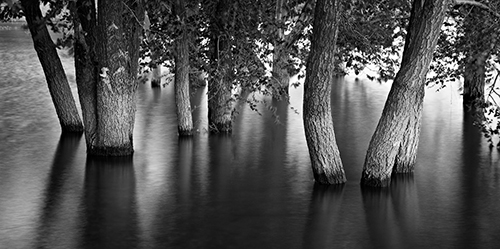
High Water Reflection, Lake Lowell
I just received my new Canon 5D Mark III and had time to go out and test shoot at the lake. I wasn’t really expecting great images, as I wanted to run some tests before using it for a “real” shoot. After looking at the files, I must say that I am quite impressed. Canon has done some great things with this camera.
I have always shot at 100 ISO to keep noise to a minimum, but after shooting a few images after sunset at higher ISO’s, I would not hesitate to use ISO 800 for fine art images. I even had to look hard to find noise at 1600. For sporting events where a little but of noise is acceptable, I would not hesitate to shoot at 25600. The noise structure at higher ISO settings was quite remarkable.
Previous to this camera I have never used auto focus, but after trying out the 61 point auto focus system, I think I might become converted! The ease of changing focus points makes it almost a no-brainer. There are occasions, however, that there is not a focus point far enough off center so that I will have to focus manually. When photographing the landscape on a tripod, for me this does not present much of a problem.
One feature that I really like is the electronic level. I found it to be very accurate and speeds up the framing process. I was composing one image that I was sure I had level, but when checking the electronic level, found that my eye was way off. I photographed both ways, and upon further inspection, found the camera’s level to be correct.
I have not put the camera through a test of all functions yet, but for what I have done, I know that I am going to like it. I can’t wait to get out later this week and continue working with this new tool.
The image posted was made on a windy evening at Lake Lowell at a location that I have photographed many times, but never quite like this. It always amazes me that there is something new to find each time I return to a familiar place. I somehow never tire of this place. Maybe it is that I never tire of photography and am always looking for something new. Training ourselves to see is such an important part of being a photographer. It is not so much training, but becoming aware of our surroundings and seeing life as it unfolds. As we become sensitive to our environment, then the images seem to reveal themselves. It is a wonderful experience to be a part of.








Recent Comments